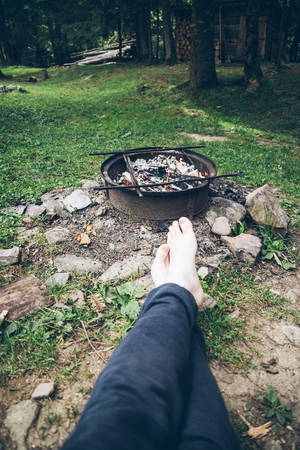1. Leave No Trace Principles
When youre out camping in Americas great outdoors, one of the most important ways to stay eco-friendly is by following the Leave No Trace principles. These simple guidelines help protect nature so everyone can enjoy it for generations to come. Whether youre hiking through a national park or pitching a tent at your favorite campground, minimizing your environmental impact should always be a top priority.
What Does “Leave No Trace” Mean?
“Leave No Trace” means making sure you dont leave anything behind that could harm the environment or wildlife. This includes trash, food scraps, and even things like soap residue or disturbed soil. The goal is to enjoy nature without changing it.
7 Core Principles of Leave No Trace
| Principle | Description |
|---|---|
| Plan Ahead and Prepare | Know the rules of the area, bring eco-friendly gear, and avoid peak times to reduce crowding. |
| Travel and Camp on Durable Surfaces | Stick to marked trails and campsites to prevent erosion and damage to fragile plants. |
| Dispose of Waste Properly | Pack out all trash, leftover food, and litter. Use restroom facilities or dig a small hole for human waste if allowed. |
| Leave What You Find | Don’t pick flowers, take rocks, or carve into trees. Leave nature as you found it. |
| Minimize Campfire Impact | Use a camp stove instead of building a fire, or use existing fire rings responsibly if fires are permitted. |
| Respect Wildlife | Observe animals from a distance. Don’t feed them—it’s harmful for their health and safety. |
| Be Considerate of Other Visitors | Keep noise levels down and respect other campers’ experiences in nature. |
Simple Tips to Practice Leave No Trace While Camping
- Bring reusable containers: Reduce single-use plastic waste by packing food in reusable bags or boxes.
- Stay on marked paths: Avoid creating new trails that can damage native plants and cause erosion.
- Pack it in, pack it out: Take all your trash with you—including biodegradable items like orange peels or apple cores.
- Avoid loud music: Let nature’s sounds take center stage and keep noise pollution to a minimum.
The Leave No Trace principles are more than just rules—theyre a mindset that helps us protect the beautiful places we love to explore. By being mindful of our actions outdoors, we can make camping more sustainable for everyone.
2. Choose Eco-Friendly Gear
One of the easiest ways to reduce your impact while camping is by choosing gear thats kind to the environment. Today, many outdoor brands are stepping up their game and offering sustainable products made from recycled, organic, or biodegradable materials. Whether it’s your tent, sleeping bag, or cooking tools, opting for eco-friendly gear helps minimize waste and supports more responsible production practices.
What to Look for in Sustainable Camping Gear
When shopping for eco-conscious gear, consider the following:
| Feature | Why It Matters | Examples |
|---|---|---|
| Recycled Materials | Reduces landfill waste and conserves resources | Tents made from recycled polyester |
| Biodegradable Components | Breaks down naturally without harming the environment | Bamboo utensils, biodegradable soap |
| Ethical Manufacturing | Ensures fair labor practices and lower carbon emissions | Brands with Fair Trade certification |
| Minimal Packaging | Cuts down on single-use plastics and excess waste | Products shipped in recyclable or compostable packaging |
Sustainable Brands to Watch
A number of companies based in the U.S. are leading the way in eco-friendly outdoor gear. Brands like Patagonia, REI Co-op, and BioLite focus on sustainability by using responsibly sourced materials and supporting environmental initiatives. By purchasing from these brands, youre not only getting quality equipment but also supporting a greener future for outdoor adventures.
Tip:
If youre just starting out or dont want to invest in new gear right away, consider borrowing from friends or renting equipment. This keeps existing products in use longer and reduces demand for new manufacturing.

3. Camp at Established Sites
When youre heading out into the great outdoors, one of the best ways to minimize your impact on nature is to camp only at established campsites or designated backcountry areas. These spots are chosen and maintained to handle foot traffic, tents, and campfires without causing long-term damage to the environment.
Pitching your tent in random, untouched areas might seem like a way to “get off the grid,” but it can actually harm delicate ecosystems. Vegetation gets trampled, wildlife habitats are disturbed, and erosion can increase—especially in fragile environments like alpine meadows or desert landscapes.
Why Choose Established Campsites?
| Benefit | Description |
|---|---|
| Protects Natural Habitats | Keeps wildlife safe by avoiding nesting and feeding areas. |
| Reduces Erosion | Campsites are often located on durable surfaces that resist wear and tear. |
| Simplifies Waste Management | Many established sites offer bear-proof trash cans or composting toilets. |
| Makes Camping Safer | You’re less likely to encounter hazards like unstable ground or falling branches. |
Tips for Finding the Right Spot
- Use Park Maps: Check official maps for marked camping zones before you go.
- Avoid Restricted Areas: Stay clear of zones marked as protected or off-limits.
- If Backpacking: Look for flat, dry areas at least 200 feet from water sources.
- No Site? Be Smart: If you must create a new site, pick durable surfaces like gravel or sand, not grass or moss.
A Small Step with Big Impact
Camping at established sites might seem like a small decision, but it goes a long way toward preserving our natural spaces for future generations. Its one of the easiest ways to ensure your outdoor adventures stay green and guilt-free.
4. Cook with Low-Impact Methods
When youre out camping, its important to think about how your cooking choices affect the environment. Traditional campfires might feel like a classic part of the outdoor experience, but they can actually cause harm to the natural surroundings. Instead, opt for low-impact cooking methods that are better for the planet and safer for everyone.
Why Avoid Open Campfires?
Open fires use up local wood resources and can lead to deforestation in popular camping areas. Worse yet, they can spark wildfires, especially during dry seasons in places like California or Colorado. Many U.S. national parks and forests now have strict rules or bans on open flames because of this risk.
Better Cooking Alternatives
Portable stoves are a smart alternative. Theyre efficient, easy to use, and don’t rely on collecting wood from the area. Plus, they leave no trace behind and help keep wildlife safe by reducing food smells and debris.
Comparison: Campfire vs. Portable Stove
| Feature | Campfire | Portable Stove |
|---|---|---|
| Environmental Impact | High (uses wood, leaves ash) | Low (no resource depletion) |
| Fire Risk | High | Low |
| Setup Time | Longer | Quick and easy |
| Leave No Trace Friendly | No | Yes |
Go Reusable and Non-Toxic
Avoid single-use items like plastic forks or paper plates. Instead, pack reusable utensils, plates, and cups made from stainless steel or BPA-free materials. Also, make sure to bring biodegradable soap and eco-safe cleaning supplies so you’re not polluting local water sources when washing up.
Eco-Friendly Cooking Checklist:
- Use a portable stove instead of a campfire
- Bring reusable cookware and utensils
- Avoid disposable plates, cups, and cutlery
- Use biodegradable soap for cleaning dishes
By choosing these low-impact cooking methods, youre helping to protect our forests, wildlife, and water sources—making sure your favorite camping spots stay beautiful for years to come.
5. Respect Wildlife and Natural Resources
When youre out camping, remember that you’re a guest in nature’s home. It’s important to respect the local wildlife and natural surroundings so that future generations can enjoy them too.
Keep Your Distance
Wild animals might look cute or curious, but its best to observe them from afar. Getting too close can stress the animals or even be dangerous for you. Use binoculars or zoom lenses if you want a closer look without intruding on their space.
Never Feed Wildlife
Feeding animals may seem harmless or kind, but it can actually hurt them. Human food isn’t good for wild animals, and feeding them can make them dependent on people, which disrupts their natural behavior and diet.
Why You Shouldn’t Feed Wildlife
| Reason | Impact |
|---|---|
| Alters natural behavior | Animals may become aggressive or lose fear of humans |
| Health risks | Human food can make animals sick or malnourished |
| Environmental imbalance | Feeding may attract invasive species or overpopulate certain areas |
Avoid Picking Plants and Disturbing Nature
Leave plants, rocks, and other natural features where they are. Picking flowers, carving trees, or stacking rocks may seem fun or harmless, but it can damage fragile ecosystems and disturb local wildlife habitats.
Simple Ways to Respect Nature:
- Stick to marked trails to avoid trampling vegetation
- Take photos instead of souvenirs
- Use biodegradable soap at least 200 feet away from water sources
- Pack out all trash and leftover food
By being mindful of wildlife and natural resources, you help keep the outdoors beautiful and balanced for everyone to enjoy.


